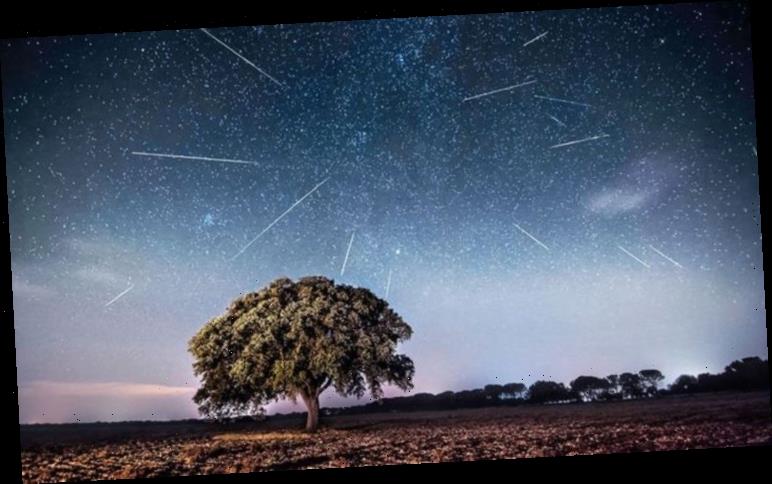The Eta Aquarids are active each year between mid-April and the end of May. Although the meteor shower favours the Southern Hemisphere, astronomers still expect dozens of shooting stars to crisscross the night skies. The meteor shower will peak this week when Earth cuts across the orbital trail of Halley’s Comet.
What is the Eta Aquarid meteor shower?
The Eta Aquarids are bits and pieces of space rock that have broken off from Comet 1P/Halley.
As the famous comet races around the Sun, its rocky body crumbles under the star’s intense heat. The debris is then left drifting in the space rock’s trail.
The Royal Observatory Greenwich in London said: “As the Earth orbits the Sun at this time of the year it ploughs into the debris left by comet Halley to produce the Eta Aquarids meteor shower – and later in the year, the Earth will once again plough into the same trail of debris left by comet Halley and will produce the Orionids meteor shower in October.”
The Eta Aquarids appear to enter our skies from the constellation Aquarius, hence their name.
The shower produces up to 50 meteors an hour but in mid-northern latitudes, the hourly rate might drop to about 10 shooting stars an hour.
READ MORE
-
Mars rover in crisis: Iconic NASA Curiosity rover faces budhet cuts
How to watch the Eta Aqaurid meteor shower this week
The Eta Aquarids will peak this week on the night of Tuesday, May 5, through to Wednesday, May 6.
Meteor showers are typically best seen after midnight and before dawn when the skies are darkest.
But Aquarius will not rise above the eastern horizon until the wee morning hours.
As a result, the Royal Observatory suggests the shower will be best seen at about 3.30am.
Great Big Lockdown Survey: Tell us what life’s like for you by answering THESE questions
But there is a catch – a bright Waxing Gibbous Moon threatens to wash out the sky.
They can be seen with the naked eye so there’s no need for binoculars
Royal Observatory Greenwich
The Full Moon will peak on Thursday, May 7, and will be very bright all week.
The Observatory said: “With a peak rate of roughly 50 to 60 meteors you may be able to spot a few but the light of the Waxing Gibbous Moon in the southwest will likely hinder your view.
“Nevertheless, if you can find a clear view of the eastern horizon, scan the skies in that area using just your eyes – they’re the best tool for the task.”
DON’T MISS…
Virgin Galactic: How YOU could soon fly into space [INSIGHT]
Meteor fireball lights up the skies over US and Canada [VIDEO]
Space travel breakthrough: Solar sail promises fast speeds in space [INSIGHT]
READ MORE
-
May full Moon: When is the Flower Moon and what is the meaning?
Now that you know when to look for the meteor shower, what other tips should you be aware of?
Meteor showers are best seen in complete darkness and far away from sources of light pollution.
Unfortunately, with the coronavirus lockdown in place, you are very limited in where you can watch the shower this year.
A private garden with an unobstructed view of the eastern sky is your best bet at catching a shooting star.
The Observatory said: “Hunting for meteors, like the rest of astronomy, is a waiting game, so it’s best to bring a comfy chair to sit on and to wrap up warm as you could be outside for a while.
Create your own survey at doopoll.co
“They can be seen with the naked eye so there’s no need for binoculars or a telescope, though you will need to allow your eyes to adjust to the dark.”
Astronomer Bruce McClure of EarthSky.org recommends people look for meteors with other members of their household.
He said: “Watch with a friend of friends, and try facing in different directions so that if someone sees a meteor, that person can call out ‘Meteor!’ to the rest.”
The shooting stars will enter the atmosphere at speeds of up to 70km per second or 156,586mph.
Remember to dress appropriately if you watch the shower from your backyard.
Source: Read Full Article






